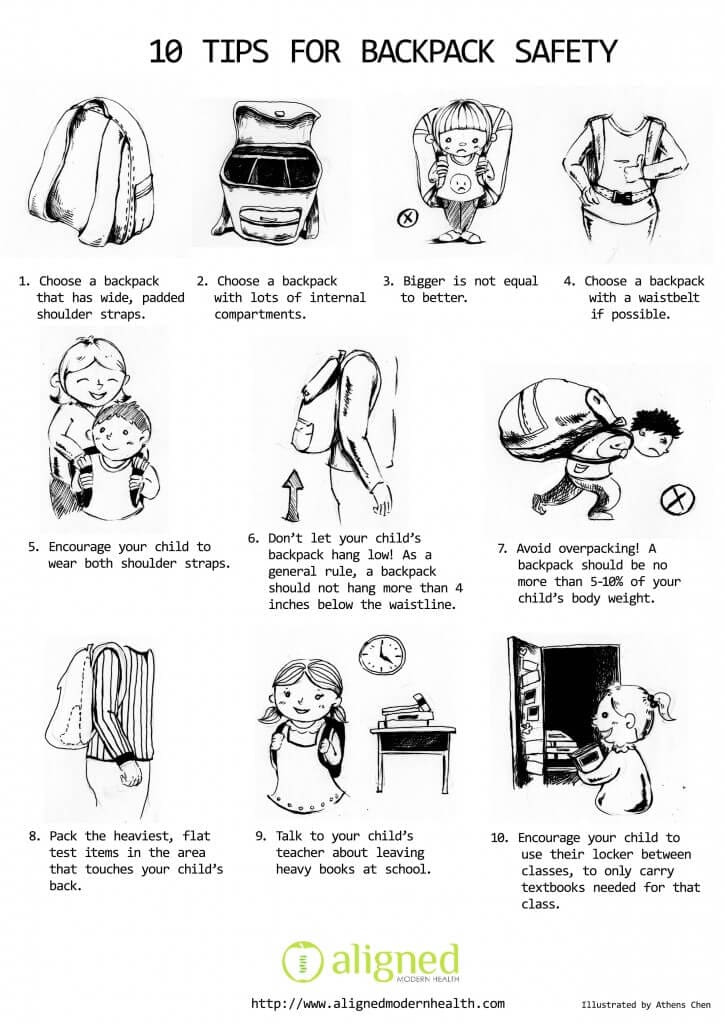Follow these tips for choosing and using a back-to-school backpack to protect your child’s back.
As kids head back to school for the next school year, parents need to make sure their children are wearing suitable backpacks. Carrying a heavy load every day can lead to back pain and injuries if the weight is not properly distributed and supported.
Choose the right backpack
The best backpacks for children have adjustable shoulder straps so they can be adjusted to fit the child’s body. According to the American Chiropractic Association, the bottom of the backpack should sit no more than four inches below the wearer’s waistline. Straps that are too long can put too much weight on the shoulders and lead to spinal misalignment. The straps should also be wide and padded to prevent the risk of them digging into the child’s skin.
Money can be tight while buying school supplies, but try not to skimp on quality. Bargain backpacks with cartoon characters on them might look tempting, but investing in a better-quality backpack can mean avoiding future spinal issues your child may experience later in life (and the pack should last longer, too!).
Highly-rated, resilient, and back-friendly packs often come with price tags between $30-80, by manufacturers which include Columbia, REI, Kelty, Eagle Creek, Land’s End, Burton, and Osprey. For budget-friendly options, search online for last year’s models; they often cost 25-50% less than what’s being newly manufactured this year, and can be found on auction sites like eBay.
Lighten the load
It is very important to avoid overloading the backpack. According to the American Chiropractic Association, a backpack should weigh no more than 10 percent of a child’s body weight. That means that if your son or daughter weighs 50 pounds, the maximum amount that he or she should ever carry is five pounds.
Encourage kids to leave heavy textbooks in their lockers at school, if possible. If lockers are not provided, consider a rolling pack with wheels, or have your child carry 1-2 books in their arms.
Carrying a backpack that is too heavy can cause kids to lean forward (or slouch), which may distort the natural curve of the spine. This distortion can lead to lower back pain, worsening of scoliosis or kyphosis, and other issues which may not become noticeable until later in the child’s development.
Pack it properly
Pack heavy items at the bottom of the bag, and position them close to the back rather than putting them in front or side pockets. Try to distribute the weight evenly to avoid putting strain on one area of the spine. Keep pointy objects in compartments away from the child’s back, to avoid causing discomfort or injury. Importantly, make sure that you show your child how to adjust the straps where they feel it’s necessary, in case they feel discomfort.
Wear it right
Kids often tend to wear their packs slung over one shoulder, to look cool and casual. This style, however, can cause pain in the muscles of their shoulders and back, due to the uneven distribution of weight. Encourage your child to use both shoulder straps at all times.
Look out for back pain symptoms
Be vigilant for back pain symptoms in children, teens, college students, or any loved one who regularly carries a heavy backpack. Slouching and complaints about shoulder/lumbar soreness are the most common signs. Simple pains in the back muscles can be lessened or relieved by taking frequent breaks from carrying heavy loads, and by maintaining good posture at all times. If back pain persists, consult the child’s physician.





